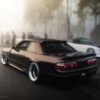[Closed] Borg Warner Efr Series Turbos
Announcements
-
Similar Content
-
Latest Posts
-
Nah. Any decent third party diagnostics unit should be able to talk Consult and all the other non-OBD protocols from back in the day. It's only 25 years since OBD started taking over. There's many cars from that ear still on the road. My mechanic's diag terminal is plenty able to talk to the other CUs in my car. Well, those that are still present, anyway. That's probably only the HICAS CU, as there never was an ABS or TCS or SRS CU, and the TCU went in the bin 25 years ago.
-
You'd be better off putting the ATTESA stuff into the boot. Same same but different, and not as bulky as a fuel cell. The space under the parcel shelf is not what I'd call "useful" boot space most of the time, even if I seem to have a guitar (not mine - child's) sitting there most days lately.
-
The main argument for lighter ARBs is that ARBs reduce the independence of the suspension. They link the left wheel to the right wheel. The lighter the ARB is, the less this linkage. When you hit a significant one wheel bump on a car with lighter springs and heavier ARBs, more of that disturbance gets transferred across to the other wheel. Whereas, with a heavier spring and lighter ARB, the impacted wheel is the only one that reacts to the hit. If you hit a significant two wheel bump, then lighter springs are the only things taking the bump as the ARB is not involved (both ends move up/down together). Then the spring rates alone determine how the car takes the hit. Softer springs (to a degree) will be more comfortable. Harder springs will accept the energy input better with less total compression (but obviously possibly more undesirable and probably uncomfortable body movement). The other significant thing to remember is that spring rate is really about coping with the rate at which loads are input to the suspension. Driving around slowly? Then any bump you hit is going to feed load into the suspension at a low rate, and you can use a low rate spring and with a low rate spring the damper has to less work to control the spring's motion. This describes street usage because it is mostly illegal to go fast or drive aggressively enough to require handling fast load inputs. But if you're going at racetrack speeds (or rally, or anything where going fast over whatever the surface is) then the loads get applied faster and you need to control that input with more spring rate, and then the dampers have to do more and that's why it all starts getting expensive. Anyway, the point of all that is, it's complicated, depends on usage and surface quality, and it's why proper race cars have a lot of adjustment and will even completely swap out springs and dampers when going from one track to another. One track might be smooth, and so even if it is a fast track there won't be rapid load input. Another track might be as rough as guts, or it might have a couple of sets of tight esses on it that require the car to heave from side to side. The rates at which loads get fed in will be different on those two tracks and probably require completely different setup. Three paragraphs and 400 words are nowhere near enough to convey how complicated this subject is and also I am nowhere near the right person to write a treatise on it, as it it not my field of expertise, or even keen interest. There are many books written on the topic, and as alluded to previously, they take differing approaches to accepting the compromises involved. So you can't read just one and think you understand.
-
Personally, i'd be dropping the extra $400 for the Pro series. I believe (at least during their original conception) they were based off the Blue series but have evolved with apparent new valving tech etc etc. The BC's were super harsh ride wise, felt like the road was covered in potholes almost (this with damping at softest), but they did feel a bit more pointy initially through corners, i felt like there was considerably more understeer at turn in on tighter radius corners (but this is not really a like or like, considering the difference in wheel size, tyre choice, track temp etc etc)
-
By Chris_Guthrie · Posted
Facts but it's okay I've ordered a new ignitor based on GTSBoy's confidence. In the meantime I did the ole jiggle tap on the maf connector with no change. Seems like the warmer it gets outside the worse the issues get. Hoping it's the ignitor. Also going to pick up some carb cleaner and try to get that iacv cleaned out real good. I'll report back once I've gathered more data. I really appreciate the feedback though guys keep it coming. Trying to learn everything I can about this car want to keep this thing for a long time.
-






Recommended Posts